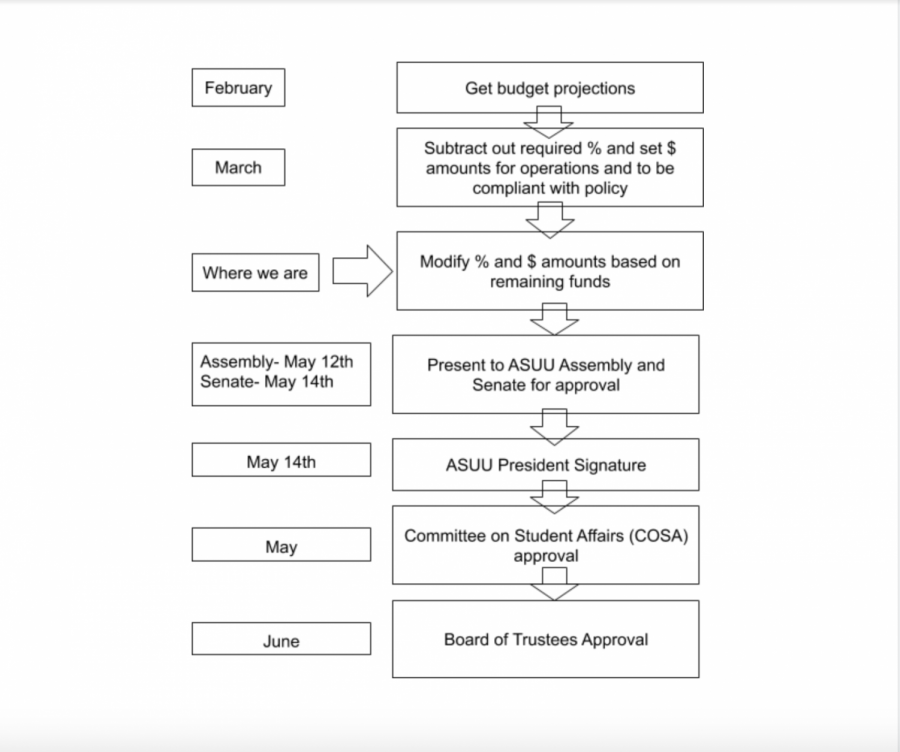ASUU and the Budget: What U Need To Know
May 13, 2020
As a new year approaches, ASUU, the student government, will gather on May 12 and 14 to discuss the impending budget for the 2020-21 school year. This budget includes funding for student organizations, large campus events, student travel, childcare and more. The Kum administration has set out to establish transparency with students regarding how ASUU manages their budget. Here is how it works:
The logistics of the budget are first determined by the Redbook, ASUU’s constitution. The money ASUU receives comes from the ASUU activity fee, which is taken out of student fees — a total of $23.12 per term. There are two major processes which influence the budget. According to Devon Cantwell, a Ph.D. student studying political science at the U and the ASUU treasurer, the budget depends on any changes to the required campus fee structure. Then it will go through the formation process.
Cantwell said in previous years, the projected budget for ASUU has been $1.8 million, but in early March this year it was anticipated to be about $1.6 million due to the COVID-19 global pandemic. The estimated projection is based on student enrollment, which is anticipated to decrease this upcoming year. Cantwell explained the $23.12 dollars can be adjusted by the Campus Fee Advisory Board, the president of the university and the Board of Regents of the state of Utah.

“There’s not a lot of wiggle room in the budget even on a normal year. And then this year, with having about $200,000 of a budget shortfall, here we are. It’s a little bit tighter. So these modification pieces are a little trickier to do,” Cantwell said.
After the estimate for the year, ASUU then subtracts the percentages, set dollar amounts and other operational expenses that are fixed. These percentages come from the Redbook. Cantwell explained these percentages are subtracted immediately. These include the 13% for Assembly, 2% for Senate, 9% for travel and 11% for the executive cabinet and 18% for the Campus Event Board as of June.
Traditionally the Campus Events Board receives 15%. The change to the CEB budget was voted on in April. Commitments like the tutoring center (3.5%) and childcare (2.5%) also get subtracted during this phase. After these subtractions, Cantwell said comes the cost of professional staff, their salaries, their benefits and any other operating expenses at this stage. Cantwell said a large sum of the budget allocation, 20%, is for these fees.
“What can get tricky here is that in years that we have projected reductions in our revenue. These percentage based funds can be hit pretty heavily,” Cantwell said.
After the budget is set, the Assembly and Senate both have to agree on the proposed amount. Cantwell said once it’s approved, the President of ASUU, Ephraim Kum, then signs the budget and it is seen, debated and voted on by the Committee on Student Affairs. Kum said to look at the ASUU budget as an investment. He said these funds go toward everything ASUU does.
“Since everyone pays that $23, it adds up to make up our budget. In turn, the things ASUU does, therefore, are meant to go back to the students in some way shape or form, whether it be resources, events, etc.,” Kum said.
Kum said the ASUU budget has always been an attempt to be reflective of what they’ve learned to be student priorities. Kum said his presidency is trying to limit the decrease in funding for programs such as the ASUU childcare or the DREAM program.
“Some of the budgets to certain boards like diversity or government relations that are playing really crucial, crucial roles in a student body, especially this year,” Kum said.
ASUU has a general reserve fund, which houses any excess money from boards. This rollover automatically happens at the end of each year. According to the redbook, article IV only allows CEB to maintain its own, independent rollover fund. Cantwell said the Assembly and Senate money also rolls over into their budget for the following year, but only up to $50,000 in excess.
The general reserve fund is only allowed to accumulate up to $200,000. However, Cantwell said once it exceeds the amount, any additional rollover amounts get rolled over into the presidential operating budget, which allows for the president to allocate at their discretion to projects or other funds within ASUU. Cantwell said ASUU is working on having tools which allow students to see the breakdown of how their money is being spent.
“We want students to be more informed and understand when we say things like ‘Actually, we do have to continue paying that fee.’ We want them to understand the rationale for why, and not like administration is just blowing off,” Cantwell said.







